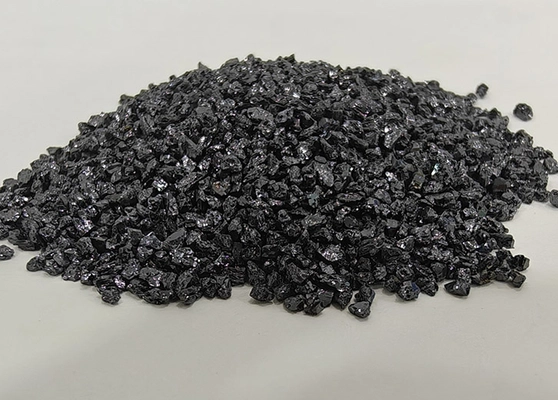What is Silicon Carbide? A Complete Introduction
Silicon carbide (SiC) is one of the most versatile and high-performance industrial materials in the world. Known for its exceptional hardness, thermal stability, and chemical resistance, it serves a broad range of applications from abrasive blasting to power electronics. This article explores the different types of silicon carbide and matches each to its corresponding grit size or physical form, giving B2B buyers and industrial professionals actionable insights.
Black Silicon Carbide (Black SiC)
Black silicon carbide contains about 95% SiC and is known for its high hardness and mechanical strength. It is widely used in grinding, cutting, and refractory applications.
Key Properties
-
Mohs hardness: ~9.2
-
Good thermal conductivity
-
Moderate purity
Applications
-
Abrasive tools
-
Deoxidizing agents
-
Refractory bricks
Available Grit Sizes
-
FEPA F series: F12 – F220 (macro grains), F240 – F1200 (micro powder)
-
FEPA P series: P16 – P2500
Green Silicon Carbide (Green SiC)
Green silicon carbide is a purer form (≥99% SiC) with slightly higher hardness than black SiC. It's typically used in high-precision grinding and polishing.
Key Properties
-
Mohs hardness: ~9.4
-
Very high purity
-
Chemically inert
Applications
-
Hard alloy finishing
-
Semiconductor wafer slicing
-
Optical polishing
Available Grit Sizes
-
FEPA F series: F12 – F220, F240 – F2000
-
FEPA P series: P400 – P6000
Cubic Silicon Carbide (3C-SiC / β-SiC)
3C-SiC has a cubic crystal structure and is used primarily in the semiconductor industry due to its high electron mobility.
Key Properties
-
Low defect density
-
High thermal conductivity
-
Thin-film friendly
Applications
-
High-temperature semiconductors
-
MEMS
-
Substrates for GaN devices
Form
-
Sold as wafers, thin films or epitaxial layers
-
Not applicable to FEPA grit sizing
Hexagonal Silicon Carbide (4H-SiC / 6H-SiC)
These are polytypes with hexagonal crystal structures widely used in power electronic devices due to superior electron mobility and breakdown strength.
Applications
-
MOSFETs
-
Schottky diodes
-
Power modules
Form
-
Available as mono-crystalline wafers (e.g. 100mm, 150mm)
-
No applicable grit sizes
Reaction Sintered Silicon Carbide (RS-SiC)
RS-SiC is a ceramic composite formed by infiltrating silicon into carbon preforms. It combines high strength with excellent oxidation resistance.
Applications
-
Heat exchangers
-
Burner nozzles
-
High-speed train braking systems
Available Grit Sizes (if powdered)
-
F36 – F90 (when used as matrix or base material)
-
Typically delivered as pre-shaped components
Hot Pressed Silicon Carbide (HP-SiC)
HP-SiC is produced by sintering SiC powders under high pressure and temperature. It offers excellent strength and chemical resistance.
Applications
-
High-temperature structural components
-
Satellite optics
-
Furnace furniture
Available Grit Sizes (for powder form)
-
F90 – F400 (if raw powder required)
-
Primarily sold as solid blocks or custom parts
Oxide Bonded Silicon Carbide (CO-SiC)
CO-SiC is made by adding oxide binders to SiC grains, forming a porous structure suitable for kiln furniture and refractory linings.
Applications
-
Kiln shelves
-
Burner blocks
-
Support beams
Available Grit Sizes
-
F12 – F90 (for shaping or as base grains)
Summary Table: Grit Size Availability by Silicon Carbide Type
| Type | Grit Sizes / Form | Notes |
|---|---|---|
| Black SiC | F12–F220, F240–F1200, P16–P2500 | Common for abrasives and refractories |
| Green SiC | F12–F220, F240–F2000, P400–P6000 | High-precision polishing and cutting |
| 3C-SiC (β-SiC) | Thin film, wafers | Semiconductor applications only |
| 4H/6H-SiC | Single crystal wafers | Power electronics, not gritted |
| RS-SiC | F36–F90 (optional) | Structural use, mainly in solid forms |
| HP-SiC | F90–F400 (optional) | High-end ceramics, also in block forms |
| CO-SiC | F12–F90 | For refractory and kiln use |
Final Thoughts
Understanding the types of silicon carbide and their available grit sizes helps procurement teams, engineers, and end users select the right material for each application—whether you're sourcing abrasive grits or high-tech wafers.
For bulk orders or detailed specs on each grade, contact a certified silicon carbide supplier and request batch-specific technical data sheets (TDS).
Would you like this version exported in HTML format for your website?
Request a Quote or Sample
Popular Products
Grünes Siliziumkarbid
View DetailsSchwarzes Siliziumkarbid
View Details